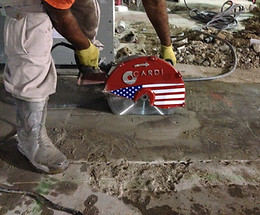
OPEN 24/7
CALL NOW
For a Free Quote
(818)645-2612

SERVICES WE PROVIDE
Core Drilling

Diamond Core Drilling techniques are used when a precise circular penetration is needed. Holes can be drilled to virtually any depth. Coring can be done in slabs and walls, on any angle. This system is dust free and has relatively low noise output. Electric drilling rigs can be utilized for drilling in sensitive locations or confined spaces.
Diamond core drilling can be used for many applications, including but not limited to holes for:
Plumbing, Electrical, HVAC, Telecommunications, Anchoring Bolts, Concrete Sample Analysis, etc.
Flat Sawing

Flat sawing is the most commonly used diamond method. It is typically used to cut
horizontal flat surfaces such as floors, bridge decks, and pavement. These saws are
typically powered by gasoline, diesel, or electric. Compared to jack hammering,
slab sawing is less time consuming, far less noisy and creates less stress to structural areas.
Typical applications for Slab sawing are:
-
Cutting plumbing and electrical trenches in slabs
-
Cutting reinforced concrete floors
-
Cutting expansion and control joints
-
Cutting sidewalks
-
Controlled demolition
Wall Sawing

Wall sawing employs a circular blade on a track-mounted machine. The track is
attached to vertical walls or steep inclines, or floors that will not permit the use of
flat saws. Wall or track sawing is typically specified to cut precise dimensional
door, vent and window openings. Straight as well as bevel cuts are possible with the wall saw.
The wall saw is also an excellent choice for creating precise openings in any
concrete structure. The diamond wall saw blade consists of a circular steel core with
diamond segments attached to the periphery. The blade is mounted on the spindle of the wall saw.
The spindle runs along the wall saw track that is typically bolted to the cutting surface.
The power source for a wall saw system is either hydraulic, air or electric. Wall saw blades can range from 18 to 72 inches in diameter and can cut up to 33 inches in depth.
Hand Sawing

Handheld sawing techniques are generally used for smaller jobs where it is
faster and more cost effective than using other cutting methods. This saws are typically
are powered by electric, gasoline and hydraulic engines. The hand saw can be used
to cut on walls or floors and can cut up to 10” deep. They are highly portable and can
access small, tight areas where cutting is needed.
Typical applications include HVAC openings in brick and cinder block, beam pockets, and small
opening in slabs and walls.
Concrete Scanning (x-ray)

Note: GPR is an acronym for “Ground Penetrating Radar”
GPR equipment transmits and receives electromagnetic waves into the ground
subsurface or other material and detects interfaces between differing materials. The interfaces
between differing materials are identified by changes which occur in the electromagnetic waves.
These changes can be voids, reinforcing bars, underground utilities (metal or plastic),
conduits, or various other items. The antenna transmits and receives a high-frequency
electromagnetic impulse into the study material and records the travel time and amplitude
of these impulses. The GPR system records these deflections and digitally process them.
Data output is typically read and interpreted by the use of a color video screen. The data can also
be digitally recorded and downloaded to a computer for further processing and interpretation.
Benefits of using GPR:
GPR is a real-time NDT technique that quickly locates the position of post tension cables, rebar, and electrical conduits embedded in concrete, eliminating dangers associated with cutting or drilling and the high costs required for their repair
if cut or damaged.
Accurate target location within a concrete slab on-grade, wall, or supported slab can be achieved more
quickly, safely, and economically with GPR services instead of other existing techniques.
GPR is a safer and less disruptive than X-Raying. GPR equipment is safe to use around people without any safety constraints or setup requirements. Because of these features, interruption of operations can be eliminated or minimized.
Additional Services
-
Reports of what is located under the surface
-
3D image reporting capabilities
Demolition

